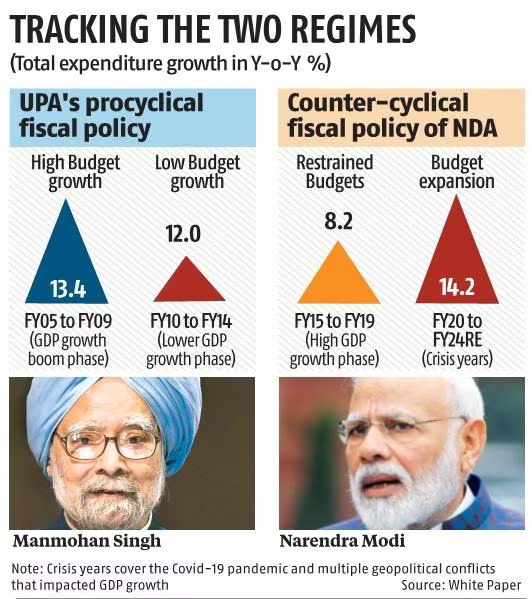The White Paper on the Indian Economy, unveiled by Finance Minister Nirmala Sitharaman in Parliament, delineates the stark contrast between the economic policies of the previous UPA government and the current NDA administration. It highlights the journey from economic fragility to a position among the top five global economies.
White Paper on Indian Economy: Major Points to Look-Upon
1. UPA Era Critique: Economic Mismanagement and Corruption
- Criticizes UPA’s economic mismanagement, fiscal indiscipline, and corruption during 2004-2014.
- Highlights policy paralysis leading to delays in project implementation and missed opportunities for growth and innovation.
- Labels the UPA’s tenure as a “lost decade” due to neglect of infrastructure and asset creation.
2. NDA’s Fiscal Prudence and Economic Rebound
- NDA’s counter-cyclical fiscal policy contrasts with UPA’s pro-cyclical approach, fostering economic stability and resilience.
- Commends NDA’s fiscal discipline amidst the COVID-19 pandemic, ensuring economic recovery without compromising fiscal health.
- Illustrates the reduction of fiscal, revenue, and primary deficits as indicators of prudent fiscal management under the NDA government.

3. Quality of Expenditure: From Populism to Investment
- Accuses UPA of prioritizing short-term populist measures over long-term infrastructure development, leading to economic constraints.
- Highlights the NDA’s focus on improving the quality of expenditure, with a shift towards higher capital expenditure and reduced revenue expenditure growth.
4. Structural Reforms and Macroeconomic Strengthening
- Emphasizes structural reforms initiated since 2014, bolstering India’s macroeconomic fundamentals.
- Cites India’s inclusion in JP Morgan’s Government Bond Index-Emerging Markets (GBI-EM) as a testament to the economy’s growing strength and attractiveness to investors.
5. Combatting Leakages and Promoting Efficiency
- Acknowledges the NDA government’s efforts to reduce leakages through Direct Benefit Transfer (DBT), citing a significant reduction in LPG subsidy leakages.




 India's Progress in Human Development In...
India's Progress in Human Development In...
 CareEdge State Rankings 2025: Maharashtr...
CareEdge State Rankings 2025: Maharashtr...
 Top 10 Most Expensive Cities To Live Aro...
Top 10 Most Expensive Cities To Live Aro...







